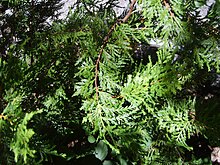| Austrocedrus | |
|---|---|

| |
| Conservation status | |
 Near Threatened (IUCN 3.1) | |
| Scientific classification | |
| Kingdom: | Plantae |
| Clade: | Tracheophytes |
| Clade: | Gymnospermae |
| Division: | Pinophyta |
| Class: | Pinopsida |
| Order: | Cupressales |
| Family: | Cupressaceae |
| Subfamily: | Callitroideae |
| Genus: | Austrocedrus Florin & Boutelje |
| Species: | A. chilensis |
| Binomial name | |
| Austrocedrus chilensis (D.Don) Pic.Serm. & Bizzarri | |
| Synonyms | |
| |
Austrocedrus is a genus of conifer belonging to the cypress family (Cupressaceae). It has only one species, Austrocedrus chilensis, native to the Valdivian temperate rain forests and the adjacent drier steppe-forests of central-southern Chile and western Argentina from 33°S to 44°S latitude. It is known in its native area as ciprés de la cordillera or cordilleran cypress, and elsewhere by the scientific name as Austrocedrus, or sometimes as Chilean incense-cedar or Chilean cedar. The generic name means "southern cedar".
It is a member of subfamily Callitroideae, a group of distinct southern hemisphere genera associated with the Antarctic flora. It is closely related to the New Zealand and New Caledonian genus Libocedrus, and some botanists treat it within this genus, as Libocedrus chilensis, though it resembles Libocedrus less than the other South American cypress genus Pilgerodendron does.
It is a slow-growing, narrowly conical evergreen tree which grows from 10 to 24 m in height, with scale-like leaves arranged in decussate pairs. The leaves are unequal in size, with pairs of larger (4–8 mm) leaves alternating with pairs of smaller (2–3 mm) leaves, giving a flattened shoot. Each leaf has a prominent white stomatal stripe along the outer edge. The cones are 5–10 mm long, with four scales, two very small sterile basal scales and two large fertile scales; each fertile scale has two winged seeds 3–4 mm long. This is a dioecious species, with male and female cones growing on separate plants.
Cordilleran cypress is found in the evergreen mountain forests of the Andes, usually on drier sites near the temperate rainforest, in open pure woods (where it is often locally dominant on the eastern slopes of the Andes in southwestern Argentina) or in association with Araucaria araucana and Nothofagus species. Young plants grow best in conditions of 8% or higher soil humidity and intermediate to high solar radiation.
It has been introduced to northwest Europe and the Pacific Northwest of North America, where it is occasionally grown in botanical gardens.
References
- The Plant List: A Working List of All Plant Species, retrieved 26 December 2016
- ^ Farjon, A. (2005). Monograph of Cupressaceae and Sciadopitys. Royal Botanic Gardens, Kew. ISBN 1-84246-068-4
- ^ Flora Chilena: Austrocedrus chilensis
- Chilebosque: Austrocedrus chilensis
- Gymnosperm Database: Austrocedrus
- ^ Caselli, Marina; Huisca, Cristian Edgardo; Loguercio, Gabriel Ángel; Defossé, Guillermo Emilio; Urretavizcaya, María Florencia (2024). "Crecimiento inicial y caracteres funcionales de ciprés de la cordillera y coihue en distintas condiciones de radiación y humedad" [Initial growth and functional traits of Austrocedrus chilensis and Nothofagus dombeyi under different radiation and humidity conditions]. Bosque (in Spanish). 45 (1): 163–176. doi:10.4067/s0717-92002024000100163.
- Mitchell, A. F. (1972). Conifers in the British Isles. Forestry Commission Booklet 33.
- " Washington Park Arboretum: Austrocedrus" (PDF). Seattle Government. Archived from the original (PDF) on 2009-03-24. Retrieved 2009-06-27.
External links
| Classification of Acrogymnospermae (living Gymnosperms) | |||||||||||||||||||||||||||||||||||||||||||||||||||||||||||||||||||||||||||
|---|---|---|---|---|---|---|---|---|---|---|---|---|---|---|---|---|---|---|---|---|---|---|---|---|---|---|---|---|---|---|---|---|---|---|---|---|---|---|---|---|---|---|---|---|---|---|---|---|---|---|---|---|---|---|---|---|---|---|---|---|---|---|---|---|---|---|---|---|---|---|---|---|---|---|---|
| |||||||||||||||||||||||||||||||||||||||||||||||||||||||||||||||||||||||||||
| Taxon identifiers | |
|---|---|
| Austrocedrus |
|
- IUCN Red List near threatened species
- Cupressaceae
- Flora of the Andes
- Flora of central Chile
- Trees of Argentina
- Trees of Chile
- Trees of mild maritime climate
- Flora of the Valdivian temperate forests
- Monotypic conifer genera
- Near threatened flora of South America
- Garden plants of South America
- Ornamental trees
- Dioecious plants